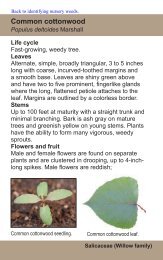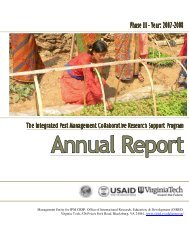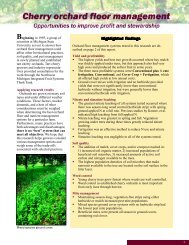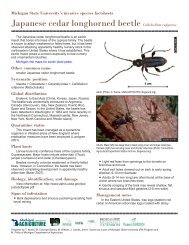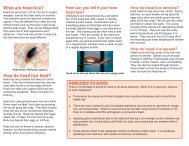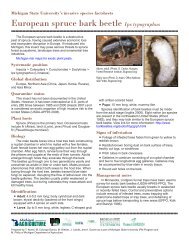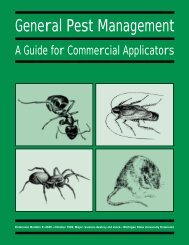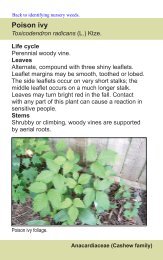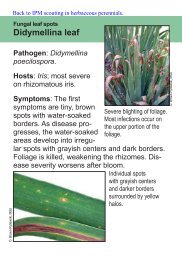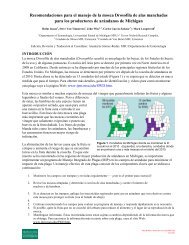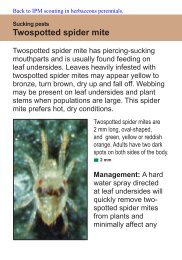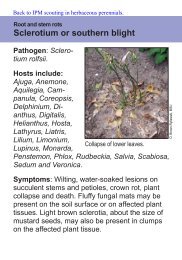Whole Manual - Michigan State University: Integrated Pest ...
Whole Manual - Michigan State University: Integrated Pest ...
Whole Manual - Michigan State University: Integrated Pest ...
You also want an ePaper? Increase the reach of your titles
YUMPU automatically turns print PDFs into web optimized ePapers that Google loves.
Always:<br />
■ Select pesticides labeled for use on your crop.<br />
■ Read and understand the label instructions and<br />
limitations before each use.<br />
■ Follow the application directions on the pesticide<br />
label.<br />
■ Contact your county MSU Extension office if<br />
you have questions or concerns about a particular<br />
pesticide.<br />
surface from wells. Every year, rain and snow seep into<br />
the soil, replenishing the groundwater. The depth at<br />
which you first find groundwater is referred to as the<br />
water table. The water table depth changes during the<br />
year, depending on the amount of water added and<br />
removed from the ground.<br />
Both surface water—visible bodies of water such as<br />
lakes, rivers, and oceans – and groundwater are subject to<br />
contamination by point and non-point source pollution.<br />
When a pollutant enters the water from a specific source,<br />
it is called point source pollution. For example, a factory<br />
that discharges chemicals into a river is a point source.<br />
Non-point source pollution refers to pollution from a<br />
generalized area or weather event, such as land runoff,<br />
precipitation, acid rain, or percolation rather than from<br />
discharge at a single location.<br />
PROTECTING OUR GROUNDWATER<br />
Groundwater is the water beneath the earth’s surface.<br />
It is found in the cracks and pores of rocks and in the<br />
spaces between sand grains and other soil particles.<br />
Many people living in rural <strong>Michigan</strong> get their drinking<br />
water from wells. It is easy to see why you should be concerned<br />
about keeping pesticides out of groundwater.<br />
Groundwater is always moving. Eventually, it reaches<br />
the earth’s surface at natural places such as lakes,<br />
springs, and streams. Sometimes it is pumped to the<br />
Keeping <strong>Pest</strong>icides Out of<br />
Groundwater and Surface Water<br />
A pesticide that has not become a gas (volatilized), or<br />
been absorbed by plants, bound to soil, or broken down<br />
can potentially migrate through the soil to groundwater.<br />
Groundwater movement is slow and difficult to predict.<br />
Substances entering groundwater in one location may<br />
turn up years later somewhere else. A difficulty in dealing<br />
with groundwater contaminants is discovering the<br />
pollution source when the problem is occurring underground,<br />
out-of-sight. Also, microbial and photodegradation<br />
(by sunlight) do not occur deep underground, so<br />
pesticides that reach groundwater break down very<br />
slowly.<br />
Cleaning contaminated groundwater or surface water<br />
is extremely difficult. Following certain practices can<br />
reduce the potential for pesticide contamination of<br />
groundwater and surface water:<br />
■ Use integrated pest management. Keep pesticide use<br />
to a minimum.<br />
■ Consider the geology of your area when locating<br />
wells, mix/load sites, or equipment washing sites. Be<br />
aware of the water table depth and how fast water<br />
moves in the geological layers between the soil surface<br />
and the groundwater.<br />
Chapter 2<br />
10<br />
Vegetable Crop <strong>Pest</strong> Management



